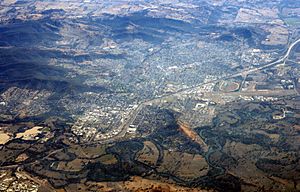Albury–Wodonga facts for kids
Quick facts for kids
|
|
|---|---|

Map of Australia with Albury–Wodonga labelled
|
|
| Country | |
| States | |
| Area | |
| • Urban | 628.3 km2 (242.6 sq mi) |
| Highest elevation | 165 m (541 ft) |
| Population
(2021)
|
|
| • Density | 155.7/km2 (403.2/sq mi) |
| • Urban | 100,095 (20th) |
| Time zone | UTC+10:00 (AEST) |
| • Summer (DST) | UTC+11:00 (AEDT) |
Albury–Wodonga is a special place in Australia. It's actually two cities, Albury and Wodonga, that are very close together. They are separated by the Murray River, which is a big river. Albury is in the state of New South Wales, and Wodonga is in Victoria. Even though they are in different states, they work together like one big community!


In the early 1970s, the Australian government had a big idea. They wanted to stop cities like Sydney and Melbourne from growing too big. Their plan was to encourage people to move to other areas, especially inland cities. Albury–Wodonga was chosen as a main focus for this plan.
The idea was to turn Albury–Wodonga into a major inland city. It was a very ambitious project! Three governments worked together: the Australian government, the New South Wales government, and the Victorian government. On January 25, 1973, their leaders signed an agreement to help Albury–Wodonga grow faster. This was a unique agreement because it crossed state borders.
The government even set up a special department to help with urban development. They put a lot of money into this plan. For example, in 1973/74, $9 million was given to Albury–Wodonga to help it grow.
However, a new government came into power later. They decided to stop the plan to encourage people to move inland. Because of this, Albury–Wodonga's population is much smaller than the 300,000 people that were hoped for in the 1970s.
Contents
Population Growth in Albury–Wodonga
The population of Albury–Wodonga has been steadily growing. From 2008 to 2013, the population increased from about 81,540 to 86,274 people. This was an average growth of 1.1% each year.
By the 2016 census, the population reached 89,007. This showed an average yearly growth rate of 1.04%.
In the 2021 census, Albury–Wodonga had a population of 97,793. Today, the combined population is around 100,000 residents. This makes it Australia's 20th largest city. Some people believe that the area now has about 250,000 people living within 100km of the twin cities.
Albury–Wodonga's Growth Centre Experience
Albury–Wodonga's experience as a "growth centre" came from Australia's plans to spread out its population after World War II. Australia got this idea from British town planning, which used a concept called "Garden City." This led to the "New Towns" approach, popular in the UK in the 1940s and 50s.
The main goals of the "New Towns" idea were to:
- Make neighborhoods and town centers stronger.
- Develop areas for businesses and factories.
- Create "greenbelts" – areas of natural land around cities.
In Australia, these new developments were sometimes called "satellite towns." They promised better housing, more open spaces, and easier access to the countryside. Some Australian cities, like Canberra, used parts of this "New Towns" idea.
By the 1970s, the government adopted this idea as a national plan. They chose several cities to grow, including Albury–Wodonga.
Both the Australian and state governments worked together on this plan. They created the Albury–Wodonga Development Corporation (AWDC). This group was in charge of land development, planning for the economy and community, planting trees, and making the whole project happen.
Strategies for Growth
One idea was to move government workers from bigger cities like Canberra and Sydney to Albury–Wodonga. This was because it was becoming very expensive to live in the large cities. The AWDC even offered nice rental homes and support for these workers and their families. However, not many government workers ended up moving.
Still, Albury–Wodonga was successful in getting an Australia Tax Office branch. Today, it also has many defense jobs because the federal government set up a major logistics center and training school there.
Another strategy was to bring universities and businesses to the area. A university would create more jobs and offer higher education for students from rural areas. This would also help keep young people in the region.
Attracting private businesses was also important. The AWDC worked to make Albury–Wodonga a strong center for distribution and manufacturing. They offered things like rental factories for new businesses and housing for employees. They also promoted the good child-care and education facilities already available. To attract very large companies, the governments even helped with social housing for employees.
Finally, keeping green spaces was a key part of the "New Towns" strategy. The AWDC planted about 3 million trees and shrubs in and around Albury–Wodonga. This was one of Australia's biggest tree-planting programs in an urban area. Today, Albury–Wodonga continues to be a leader in environmental efforts.
See also
 In Spanish: Albury-Wodonga para niños
In Spanish: Albury-Wodonga para niños

